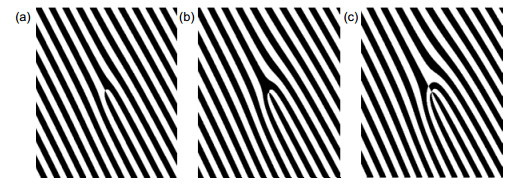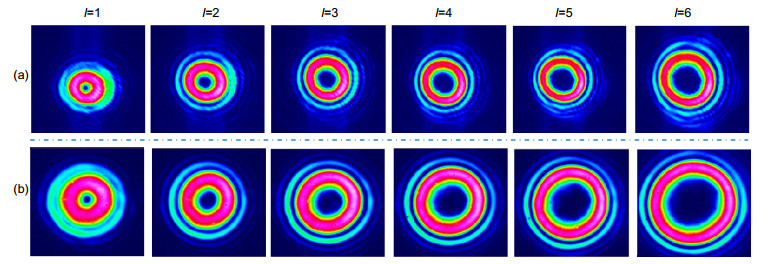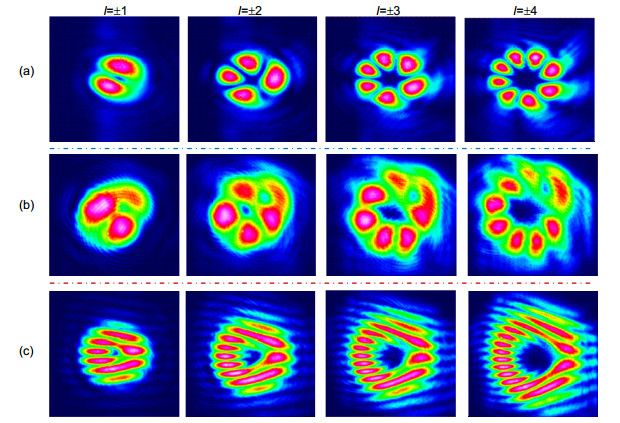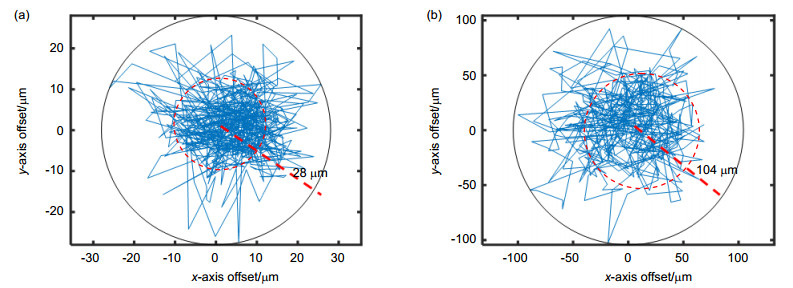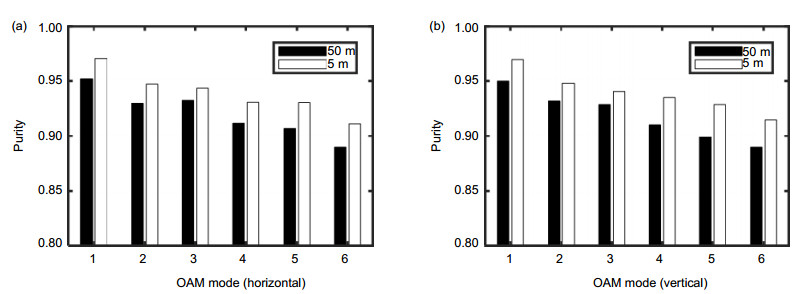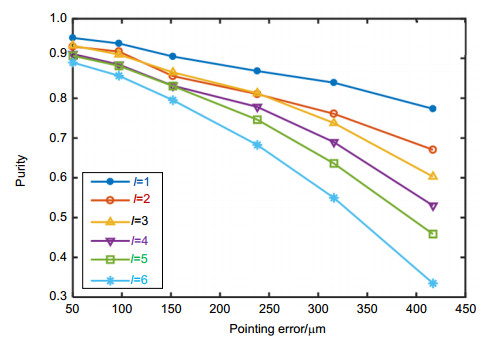Experimental study on short-distance free-space transmission characteristics of OAM beam
-
摘要
实验研究了光轨道角动量(OAM)光束的短距离自由空间传输特性。在实验装置中使用数字微镜器件(DMD)产生OAM光束,传输距离为室内0~50 m。在接收端使用空间光束模场分析仪测量传输后的OAM光束光强分布,实验研究了不同传输距离下OAM光束的模场展宽效应,并通过干涉法研究了传输对OAM光束相位分布特性的影响。在接收端使用一个单路Sagnac干涉仪对传输后OAM光束的各阶模式进行分离检测,实验研究了不同距离下传输导致的OAM光束能量从产生的模式向临近各阶模式的迁移再分配。使用局部加热的方法模拟较强的大气湍流扰动,实验研究了较强湍流对OAM光束模式特性的影响。实验结果表明,在湍流扰动下,OAM光束的拓扑荷值越大传输后模式纯度的劣化越严重。

Abstract
The short-distance free-space transmission characteristics of the optical orbital angular momentum (OAM) beam were experimentally studied. The transmission distance is 0~50 m indoors. A digital micromirror device (DMD) was used in the experimental setup to generate the OAM beam. At the receiver, a spatial beam analyzer was used to measure the intensity pattern of the OAM beam. The beam broadening effect of the OAM beam at different transmission distances was studied. The phase pattern of the OAM beam was studied by the interferometric method. At the receiver, a single path Sagnac interferometer (SPSI) was used to separate and detect the intensity of modes of the OAM beam. The effects of energy migration from the sending mode to the sideband modes of the OAM beam were studied. A heater was used to generate the strong turbulence to simulate the influence to the OAM beam mode transmission characteristics. The experimental results show that the OAM beam with large mode topological charge has more deterioration of the mode purity after transmission in the strong turbulence.
-
Overview

Overview: Orbital angular momentum (OAM) of light as a degree of freedom provides an infinite number of orthogonality states with different mode topological charges. The application of OAM mode multiplexing technology in free space and fiber optical communication has become one of the most active research areas of communication. A huge challenge for OAM beam free space optical communication system is the disturbance of atmospheric turbulence. The effects include beam point jitter, intensity and phase fluctuation, damage beam pattern and crosstalk between OAM modes. Mode purity of OAM beam is very important for free space OAM mode multiplexing optical communication system. Therefore, it is significant to carry out experimental research on the actual free space transmission of OAM beams.
The short-distance free-space transmission characteristics of the OAM beam were experimentally studied. The transmission distance is 0~50 m indoors. The atmospheric environment is weak and stable. A digital micromirror device (DMD) was used to generate the OAM beam in the experimental setup. The DMD model is DLP4500 with micromirror numbers of 912×1140. At the receiver, a spatial beam analyzer was used to measure the intensity pattern of the OAM beam. The beam analyzer uses a 12-bit 1.4 megapixel CCD as the detector. The detection aperture size is 9.5 mm and the pixel size is 6.45 μm×6.45 μm. The beam broadening effect of the OAM beam at different transmission distances was studied. The measured data was compared with the theoretical results of the OAM beam propagation broadening calculated by the Fresnel diffraction model, which verifies they are consistent in trend. The phase pattern of the OAM beam was studied by the interferometric method. At the receiver, a single path Sagnac interferometer (SPSI) was used to separate and detect the intensity of modes of the OAM beam. The SPSI has higher stability than the Mach-Zehnder interferometer. The effects of energy coupling between the sending mode and the sideband modes of the OAM beam were studied. An electric heater was used to generate the strong turbulence to simulate the influence to the OAM beam mode transmission characteristics. The average pointing deviation was characterized turbulence strength approximately.
The experimental results show that the longer transmission distance and stronger turbulence cause larger energy coupling of the OAM beam from the sending mode to the sideband modes, and the OAM beam with larger mode topological charge has more deterioration of the mode purity after transmission in the strong turbulence. The results are helpful for analyzing the bit error rate (BER) characteristics of the OAM mode multiplexed optical communication system.
-

-
图 1 OAM光束自由空间传输系统。(a) 50 m的室内OAM光束传输自由空间光路;(b) OAM光束的发射端的实验装置;(c) OAM光束的接收端的实验装置
Figure 1. Experimental setup. (a) 50 m OAM beam indoor free-space link; (b) The transmitter of OAM beam; (c) The receiver of OAM beam. NPBS: Non-polarizing beam-splitter; BE: Beam expander; M: Mirror; HWP: Half wavelength plate; DP: Dove prism; Tx-tel: Transmitter-telescope; Rx-tel: Receiver-telescope; Pol: Polarizer; CBP: Camera beam profiler
-
参考文献
[1] Allen L, Beijersbergen M W, Spreeuw R J C, et al. Orbital angular momentum of light and the transformation of Laguerre-Gaussian laser modes[J]. Physical Review A, 1992, 45(11): 8185-8189. doi: 10.1103/PhysRevA.45.8185
[2] O'neil A T, MacVicar I, Allen L, et al. Intrinsic and extrinsic nature of the orbital angular momentum of a light beam[J]. Physical Review Letters, 2002, 88(5): 053601. doi: 10.1103/PhysRevLett.88.053601
[3] Grier D G. A revolution in optical manipulation[J]. Nature, 2003, 424(6950): 810-816. doi: 10.1038/nature01935
[4] Chen L X, Lei J J, Romero J. Quantum digital spiral imaging[J]. Light: Science & Applications, 2014, 3(3): e153. doi: 10.1038/lsa.2014.34
[5] Mirhosseini M, Magaña-Loaiza O S, O'Sullivan M N, et al. High-dimensional quantum cryptography with twisted light[J]. New Journal of Physics, 2015, 17(3): 033033. doi: 10.1088/1367-2630/17/3/033033
[6] Wang J, Yang J Y, Fazal I M, et al. Demonstration of 12.8-bit/s/Hz spectral efficiency using 16-QAM signals over multiple orbital-angular-momentum modes[C]//Proceedings of the 2011 37th European Conference and Exhibition on Optical Communication, Geneva, Switzerland, 2011: 1-3.
https://ieeexplore.ieee.org/document/6066145 [7] Ren Y X, Wang Z, Xie G D, et al. Free-space optical communications using orbital-angular-momentum multiplexing combined with MIMO-based spatial multiplexing[J]. Optics Letters, 2015, 40(18): 4210-4213. doi: 10.1364/OL.40.004210
[8] Zhao N B, Li X Y, Li G F, et al. Capacity limits of spatially multiplexed free-space communication[J]. Nature Photonics, 2015, 9(12): 822-826. doi: 10.1038/nphoton.2015.214
[9] Ramachandran S, Kristensen P, Yan M F. Generation and propagation of radially polarized beams in optical fibers[J]. Optics Letters, 2009, 34(16): 2525-2527. doi: 10.1364/OL.34.002525
[10] Ren H R, Li X P, Zhang Q M, et al. On-chip noninterference angular momentum multiplexing of broadband light[J]. Science, 2016, 352(6287): 805-809. doi: 10.1126/science.aaf1112
[11] Fazal I M, Ahmed N, Wang J, et al. 2 Tbit/s free-space data transmission on two orthogonal orbital-angular-momentum beams each carrying 25 WDM channels[J]. Optics Letters, 2012, 37(22): 4753-4755. doi: 10.1364/OL.37.004753
[12] Wang J, Yang J Y, Fazal I M, et al. Terabit free-space data transmission employing orbital angular momentum multiplexing[J]. Nature Photonics, 2012, 6(7): 488-496. doi: 10.1038/nphoton.2012.138
[13] Zhao Y F, Liu J, Du J, et al. Experimental demonstration of 260-meter security free-space optical data transmission using 16-QAM carrying orbital angular momentum (OAM) beams multiplexing[C]//Proceedings of 2016 Optical Fiber Communications Conference and Exhibition, Anaheim, CA, USA, 2016: 1-3.
https://ieeexplore.ieee.org/document/7537325 [14] Fried D L. Statistics of a geometric representation of wavefront distortion[J]. Journal of the Optical Society of America, 1965, 55(11): 1427-1435. doi: 10.1364/JOSA.55.001427
[15] 邢建斌, 许国良, 张旭苹, 等.大气湍流对激光通信系统的影响[J].光子学报, 2005, 34(12): 1850-1852. http://d.old.wanfangdata.com.cn/Periodical/gzxb200512023
Xing J B, Xu G L, Zhang X P, et al. Effect of the atmospheric turbulence on laser communication system[J]. Acta Photonica Sinica, 2005, 34(12): 1850-1852. http://d.old.wanfangdata.com.cn/Periodical/gzxb200512023
[16] Roux F S. Infinitesimal-propagation equation for decoherence of an orbital-angular-momentum-entangled biphoton state in atmospheric turbulence[J]. Physical Review A, 2011, 83(5): 053822. doi: 10.1103/PhysRevA.83.053822
[17] Aksenov V P, Pogutsa C E. Fluctuations of the orbital angular momentum of a laser beam, carrying an optical vortex, in the turbulent atmosphere[J]. Quantum Electronics, 2008, 38(4): 343-348. doi: 10.1070/QE2008v038n04ABEH013576
[18] Anguita J A, Neifeld M A, Vasic B V. Turbulence-induced channel crosstalk in an orbital angular momentum-multiplexed free-space optical link[J]. Applied Optics, 2008, 47(13): 2414-2429. doi: 10.1364/AO.47.002414
[19] Zhang Y X, Cang J. Effects of turbulent aberrations on probability distribution of orbital angular momentum for optical communication[J]. Chinese Physics Letters, 2009, 26(7): 074220. doi: 10.1088/0256-307X/26/7/074220
[20] Zhao S M, Wang L, Zou L, et al. Both channel coding and wavefront correction on the turbulence mitigation of optical communications using orbital angular momentum multiplexing[J]. Optics Communications, 2016, 376: 92-98. doi: 10.1016/j.optcom.2016.04.075
[21] Malik M, O'Sullivan M, Rodenburg B, et al. Influence of atmospheric turbulence on optical communications using orbital angular momentum for encoding[J]. Optics Express, 2012, 20(12): 13195-13200. doi: 10.1364/OE.20.013195
[22] Tyler G A, Boyd R W. Influence of atmospheric turbulence on the propagation of quantum states of light carrying orbital angular momentum[J]. Optics Letters, 2009, 34(2): 142-144. doi: 10.1364/OL.34.000142
[23] Rodenburg B, Lavery M P J, Malik M, et al. Influence of atmospheric turbulence on states of light carrying orbital angular momentum[J]. Optics Letters, 2012, 37(17): 3735-3737. doi: 10.1364/OL.37.003735
[24] Krenn M, Fickler R, Fink M, et al. Communication with spatially modulated light through turbulent air across Vienna[J]. New Journal of Physics, 2014, 16: 113028. doi: 10.1088/1367-2630/16/11/113028
[25] Lavery M P J, Peuntinger C, Günthner K, et al. Free-space propagation of high-dimensional structured optical fields in an urban environment[J]. Science Advances, 2017, 3(10): e1700552. doi: 10.1126/sciadv.1700552
[26] Ren Y X, Li M, Huang K, et al. Experimental generation of Laguerre-Gaussian beam using digital micromirror device[J]. Applied Optics, 2010, 49(10): 1838-1844. doi: 10.1364/AO.49.001838
[27] Chen Y, Fang Z X, Ren Y X, et al. Generation and characterization of a perfect vortex beam with a large topological charge through a digital micromirror device[J]. Applied Optics, 2015, 54(27): 8030-8035. doi: 10.1364/AO.54.008030
[28] Li S X, Wang Z W. Generation of optical vortex based on computer-generated holographic gratings by photolithography[J]. Applied Physics Letters, 2013, 103(14): 141110. doi: 10.1063/1.4823596
[29] 蔡田, 张晓波, 叶芳伟, 等.产生拉盖尔-高斯模的全息光栅实验研究[J].光学学报, 2005, 25(11): 1457-1460. doi: 10.3321/j.issn:0253-2239.2005.11.004
Cai T, Zhang X B, Ye F W, et al. Experimental study of the holographic grating to produce the Laguerre-Gaussian modes[J]. Acta Optica Sinica, 2005, 25(11): 1457-1460. doi: 10.3321/j.issn:0253-2239.2005.11.004
[30] Chong S H, Parthasarathy A B, Kavuri V C, et al. Intraoperative NIR diffuse optical tomography system based on spatially modulated illumination using the DLP4500 evaluation module (Conference Presentation)[J]. Proceedings of SPIE, 2017, 10117: 101170D. doi: 10.1117/12.2253264
[31] Wang F X, Chen W, Li Y P, et al. Single-path Sagnac interferometer with Dove prism for orbital-angular-momentum photon manipulation[J]. Optics Express, 2017, 25(21): 24946-24959. doi: 10.1364/OE.25.024946
[32] Moreno I, Paez G, Strojnik M. Polarization transforming properties of Dove prisms[J]. Optics Communications, 2003, 220(4-6): 257-268. doi: 10.1016/S0030-4018(03)01423-8
[33] Jaiswal V K, Singh R P, Simon R. Producing optical vortices through forked holographic grating: study of polarization[J]. Journal of Modern Optics, 2010, 57(20): 2031-2038. doi: 10.1080/09500340.2010.515748
[34] 丁攀峰, 蒲继雄.拉盖尔高斯涡旋光束的传输[J].物理学报, 2011, 60(9): 094204. http://d.old.wanfangdata.com.cn/Periodical/shlgdxxb201504013
Ding P F, Pu J X. Propagation of Laguerre-Gaussian vortex beam[J]. Acta Physica Sinica, 2011, 60(9): 094204. http://d.old.wanfangdata.com.cn/Periodical/shlgdxxb201504013
[35] Yura H T. Short-term average optical-beam spread in a turbulent medium[J]. Journal of the Optical Society of America, 1973, 63(5): 567-572. doi: 10.1364/JOSA.63.000567
[36] Barry J D, Mecherle G S. Beam pointing error as a significant design parameter for satellite-borne, free-space optical communication systems[J]. Optical Engineering, 1985, 24(6): 241049. doi: 10.1117/12.7973628
[37] Yang F, Cheng J L, Tsiftsis T A. Free-space optical communications with generalized pointing errors[C]//Proceedings of 2013 IEEE International Conference on Communications, Budapest, Hungary, 2013: 3943-3947.
[38] 张韵, 王翔, 赵尚弘, 等. Exponentiated Weibull大气湍流下PSK-OFDM机载光链路性能分析[J].光电工程, 2018, 45(2): 170540. doi: 10.12086/oee.2018.170540
Zhang Y, Wang X, Zhao S H, et al. BER performance for PSK-OFDM optical link over Exponentiated Weibull atmospheric turbulence[J]. Opto-Electronic Engineering, 2018, 45(2): 170540. doi: 10.12086/oee.2018.170540
[39] Andrews L C, Phillips R L. Laser Beam Propagation Through Random Media[M]. 2nd ed. Bellingham, WA: SPIE Press, 2005.
[40] Beckmann P, Spizzichino A. The Scattering of Electromagnetic Waves from Rough Surfaces[M]. Norwood, MA: Artech House, 1987: 511.
[41] Vasnetsov M V, Pas'Ko V A, Soskin M S. Analysis of orbital angular momentum of a misaligned optical beam[J]. New Journal of Physics, 2005, 7(1): 46. doi: 10.1088/1367-2630/7/1/046
[42] Abramowitz M, Stegun I A. Handbook of Mathematical Functions: with Formulas, Graphs, and Mathematical Tables[M]. Wash: US GPO, 1964.
[43] 倪小龙, 宋卢军, 姜会林, 等.对流式湍流模拟装置湍流模拟稳定性研究[J].激光与光电子学进展, 2015, 52(10): 100102. doi: 10.3788/lop52.100102
Ni X L, Song L J, Jiang H L, et al. Research on turbulence stability characteristic of convection turbulence simulator[J]. Laser & Optoelectronics Progress, 2015, 52(10): 100102. doi: 10.3788/lop52.100102
-
访问统计


 E-mail Alert
E-mail Alert RSS
RSS
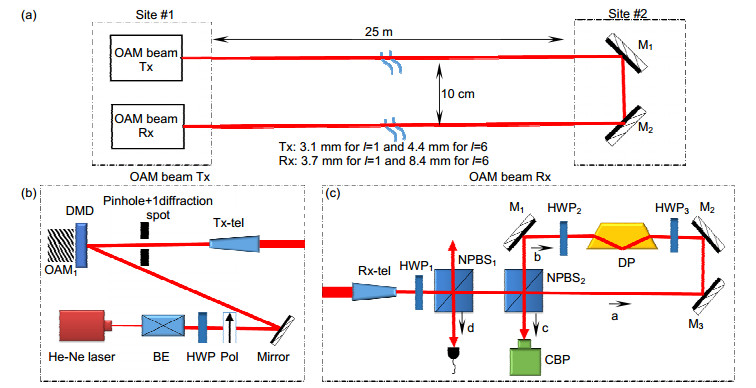
 下载:
下载:
